Enhanced TDS
Identification & Functionality
- Chemical Family
- Fillers Included
- RTU Product Type
- Technologies
- Product Families
Features & Benefits
Applications & Uses
- Composites Processing Methods
- Cure Method
- Product End Uses
- Markets
- Applications
- Application Information
Indoor electrical insulators for medium and high voltage, such as switch and apparatus components, pin insulators, bushings, as well as power distribution, current and voltage transformers.
Properties
- Physical Form
- Notes
End properties of this system have been tested with the silica filler, quality SUK II. No flexibilizer is added to produce switch parts, pin insulators, but we recommend to add some flexibilizer DY 045 (max 20 ppw) for the production of instrument and distribution transformers.
Technical Details & Test Data
- System Preparation
General instructions for preparing liquid resin systems.
Long pot life is desirable in the processing of any casting resin system. Mix all of the components together very thoroughly at room temperature or slightly above and under vacuum. Intensive wetting of the filler is extremely important. Proper mixing will result in:
- Better flow properties and reduced tendency to shrinkage
- Lower internal stresses and therefore improved mechanical properties on object
- Improved partial discharge behaviour in high voltage applications.
For the mixing of medium to high viscous casting resin systems and for mixing at lower temperatures, we recommend special thin film degassing mixers that may produce additional self-heating of 10-15°C as a result of friction. For low viscous casting resin systems, conventional anchor mixers are usually sufficient.
In larger plants, two pre-mixers are used to mix the individual components with the respective quantities of fillers and additives under vacuum. Metering pumps then feed these premixes to the final mixer or a continuous mixer. The individual premixes can be stored at elevated temperature (about 60°C) for up to about 1 week, de-pending on formulation. Intermittent agitation during storage is advisable to prevent filler sedimentation.
Mixing time can vary from 0.5 to 3 hours, depending on mixing temperature, quantity, mixing equipment and the particular application. The required vacuum is 0.5 to 8 mbar. Degassing time is recommended at least 1 hour. The vapour pressure of the individual components should be taken into account.
In the case of dielectrically highly stressed parts, we recommend checking the quality consistency and pre-drying of the filler. Their moisture content should be max. 0.2%.
- Processing Information
The effective pot-life of the mix is about 1 to 2 days at temperatures below 25°C. Conventional batch mixers should be cleaned once a week or at the end of work. For longer interruptions of work, the pipes of the mixing and metering installations have to be cooled and cleaned with the resin component to prevent sedimentation and/or undesired viscosity increase. Interruptions over a week-end (approx. 48h) without cleaning are possible if the pipes are cooled at temperatures below 18°C. For data on viscosity increase and gel time at various temperatures, refer to Figs: 4.1 and 4.5.
Mold temperature
APG process 120 - 150°C
Conventional vacuum casting 80 - 100°C
Demolding times (depending on reactivity, mold temperature and casting volume)
APG process 10 - 45 min
Conventional vacuum casting 1 - 6 h
Cure conditions (minimal postcure)
APG process 10h at 140°C
Conventional vacuum casting 4h at 80°C and 8h at 140°C
To determine whether crosslinking has been carried to completion and the final proper- ties are optimal, it is necessary to carry out relevant measurements on the actual object or to measure the glass transition temperature. Different gelling and cure cycles in the manufacturing process could lead to a different crosslinking and glass transition temperature respectively.Processing Viscosities

Fig.4.1: Viscosity increase at 25, 40 and 60°C (measurements with Rheomat 115) (Shear rate D = 10 s-1) (Accelerator DY 062, part : 0.8 pbw)
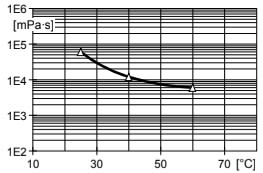
Fig.4.2: Initial viscosity as a function of temperature (measurements with Rheomat 115, D =10 s-1) (without Flex. / Filler load: 65%)
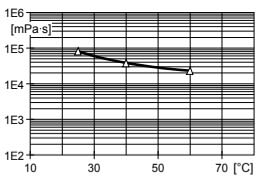
Fig.4.3: Initial viscosity as a function of temperature (measurements with Rheomat 115, D =10 s-1) (Flex. DY 045,: 20 pbw / Filler load: 65%)
Gelation and Cure Times
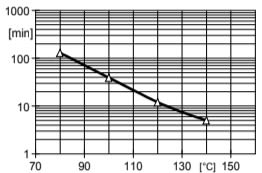
Fig.4.4: Geltime measured with Gelnorm Instrument as a function of temperature (ISO 9396) (Acc. DY 062: 0.8 pbw)
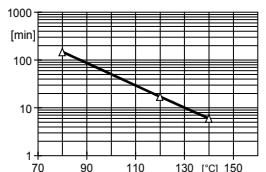
Fig.4.5: Geltime measured with Gelnorm Instrument as a function of temperature (ISO 9396) (Acc. DY 062: 0.8 pbw/ Flex. DY 045: 20 pbw)
Mechanical and Physical Properties
Key Value Unit Test Method Condition Tensile strength 75 - 90 MPa ISO 527 Cured for 10h at 140°C
Elongation at break 0.65 - 1.00 % ISO 527 Cured for 10h at 140°C
E modulus from tensile test 11,000 - 13,000 MPa ISO 527 Cured for 10h at 140°C
Flexural strength 120 - 135 MPa ISO 178 Cured for 10h at 140°C
Surface strain 1.0 - 1.3 % ISO 178 Cured for 10h at 140°C
E modulus from flexural test 11000 - 12100 MPa ISO 178 Cured for 10h at 140°C
Compressive strength 150 - 180 MPa ISO 604 Cured for 10h at 140°C
Compression set 8 - 11 % ISO 604 Cured for 10h at 140°C
Impact strength 5 - 9 kJ/m² ISO 179 Cured for 10h at 140°C
Critical stress intensity factor (K1C) 2.1 - 2.4 MPa·m¹/² CG 216-0/89 Cured for 10h at 140°C
Specific energy at break (G1C) 380 - 430 J/m² CG 216-0/89 Cured for 10h at 140°C
Martens temperature 100 - 110 °C DIN 53458 Cured for 10h at 140°C
Glass transition temperature (DSC) 105 - 120 °C ISO 11357-2 Cured for 10h at 140°C
Coefficient of linear thermal expansion (20-60°C) 31 - 36 x10⁻⁶ K⁻¹ ISO 11359-2 Cured for 10h at 140°C
Thermal conductivity 0.90 - 1.00 W/m·K Similar to ISO 8894-1 Cured for 10h at 140°C
Flammability (Thickness of specimen: 4 mm) HB UL 94 Cured for 10h at 140°C
Flammability (Thickness of specimen: 12 mm) V1 UL 94 Cured for 10h at 140°C
Water absorption (10 days at 23°C) 0.05 - 0.10 % by wt ISO 62 Cured for 10h at 140°C
Water absorption (60 minutes at 100°C) 0.05 - 0.10 % by wt ISO 62 Cured for 10h at 140°C
Decomposition temperature (TGA) < 350 °C DTA Cured for 10h at 140°C
Density (Filler load: 65% by weight) 1.75 - 1.85 g/cm³ ISO 1183 Cured for 10h at 140°C
Electrical Properties
Key Value Unit Test Method Condition Breakdown strength (IEC 60243-1) 18 - 22 kV/mm IEC 60243-1 Cured for 10h at 140°C
Diffusion breakdown strength (DIN/VDE 0441/1) HD 2 Class DIN/VDE 0441/1 Cured for 10h at 140°C
Temperature of specimen after test < 23 °C N/A Cured for 10h at 140°C
HV arc resistance (IEC 61621) 185 - 190 sec IEC 61621 Cured for 10h at 140°C
Tracking resistance (IEC 60112) CTI > 600 - 0.0 IEC 60112 Cured for 10h at 140°C
Tracking resistance (with test solution B) CTI > 600M - 0.0
IEC 60112 Cured for 10h at 140°C
Electrolytic corrosion (IEC 60426) A-1 Grade IEC 60426 Cured for 10h at 140°C
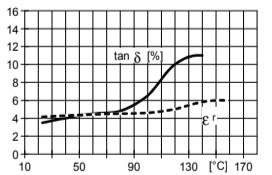
Fig.6.1: Loss factor (tan δ) and dielectric constant (εr) as a function of temperature (measurement frequency: 50 Hz, IEC 60250)
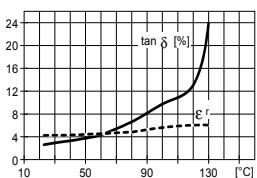
Fig.6.2: Loss factor (tan δ) and dielectric constant (εr) as a function of temperature (measurement frequency: 50 Hz, IEC 60250) (Acc. DY 062, part : 0.8 pbw/ Flex. DY 045 Part : 20 pbw)
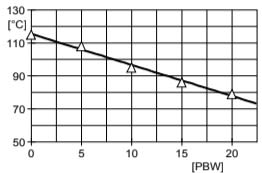
Fig.7.1: Glass Transition Temperature (TG) as a function of Flex part (pbw) (ISO 11357-2)
Safety & Health
- Industrial Hygiene
Mandatory and recommended industrial hygiene procedures should be followed whenever our products are being handled and processed.
- Handling Precautions
Protective clothing
Yes Gloves Essential Arm protector Recommended when skin contact likely
Goggestery diasses
Yes Respirator/dust mask
Recommended Skin protection before starting work
Apply barrier cream to exposed skin
Skin protection after washing
Apply barrier or nourishing cream
Skin protection cleansing of contaminated skin
Dab off with absorbent paper, wash with warm water and alkali-free soap, then dry with disposable towels. Do not use solvents
Clean shop requirements
Cover workbenches, etc. with light coloured paper. Use disposable breakers, etc.
Disposal of spillage
Soak up with sawdust or cotton waste and deposit in plastic-lined bin
Ventilation: of workshop
Renew air 3 to 5 times an hour
Ventilation: of workplace
Exhaust fans. Operatives should avoid inhaling vapours.
- First Aid Information
- Contamination of the eyes by resin, hardener or casting mix should be treated immediately by flushing with clean, running water for 10 to 15 minutes. A doctor should then be consulted.
- Material smeared or splashed on the skin should be dabbed off, and the contaminated area then washed and treated with a cleansing cream (see above). A doctor should be consulted in the event of severe irritation or burns. Contaminated clothing should be changed immediately.
- Anyone taken ill after inhaling vapours should be moved out of doors immediately.
Storage & Handling
- Storage Conditions
Store the components at 18-25°C, in tightly sealed and dry original containers. Under these conditions, the shelf life will correspond to the expiry date stated on the label. Product specific advise regarding storage can be found on product label. After this date, the product may be processed only following reanalysis. Partly emptied containers should be closed tightly immediately after use.
Other
- Application Information
Value Units Test Method / Conditions Mix Ratio 0.005-0.015 %(W) %(W) Accelerator : Resin Mix Ratio 3.45-3.85 %(W) %(W) Filler : Resin Mix Ratio 0.0-0.2 %(W) %(W) Flexibilizer : Resin Mix Ratio 0.85 %(W) %(W) Hardener : Resin
